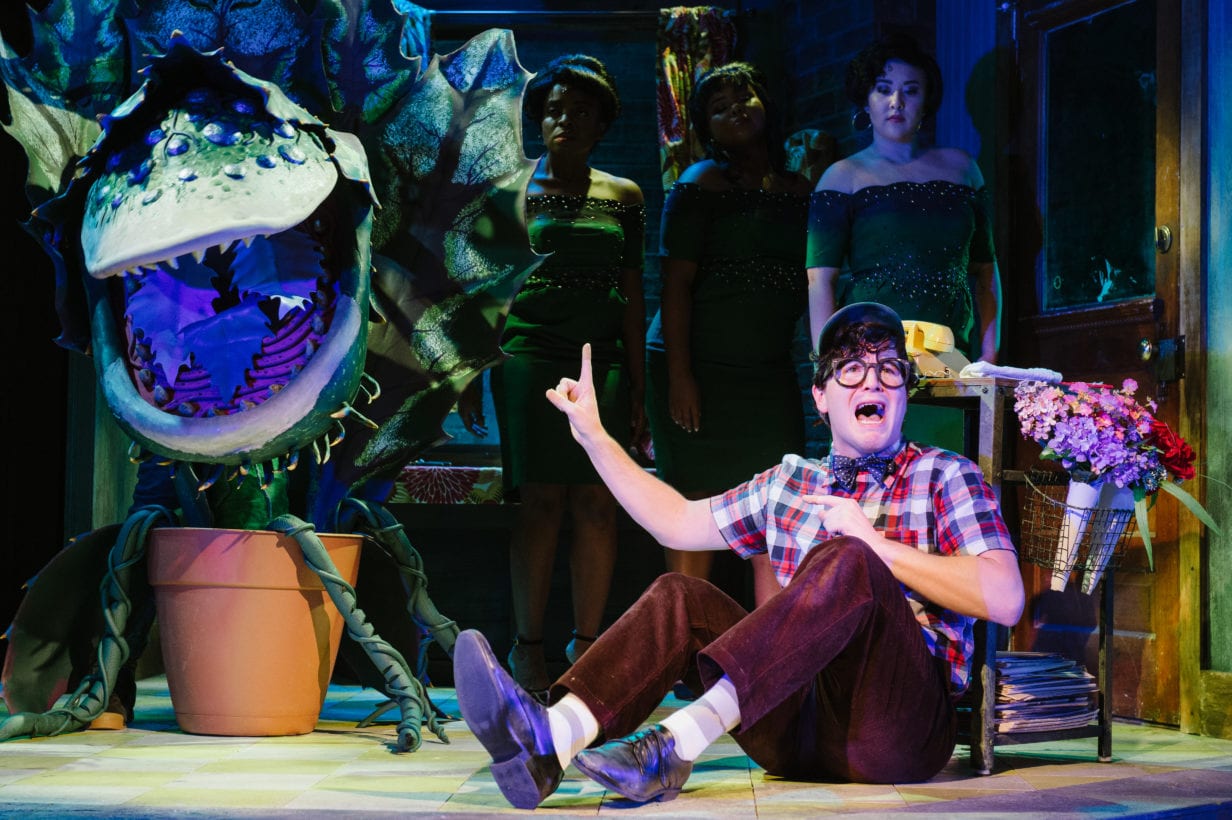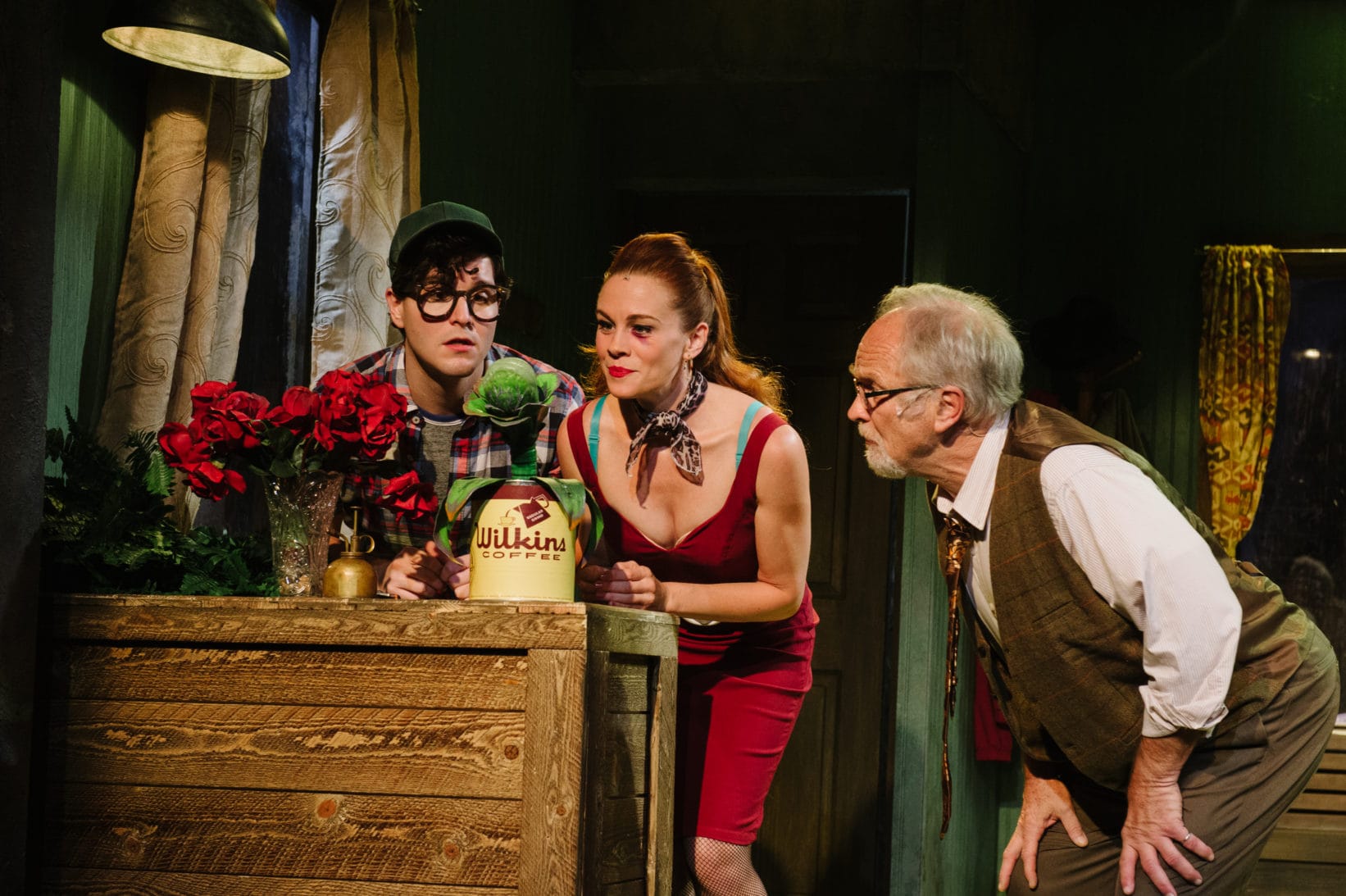From its beginnings as a very low-budget 1960 Roger Corman B-picture horror flick (a young Jack Nicholson had a minor role), Little Shop of Horrors has been an irresistible salad of corrupted innocence, yearning for love, violence deserved and undeserved, and the bloodiest of botanical appetites. In its 1982 off-Broadway musical form, written by Howard Ashman and Alan Menken (who went on to bigger, if not necessarily better, things in the Disney corporate musical empire), it led to a 1986 movie and, this year, to revivals in New York and Pasadena as well as Constellation Theatre’s excellent current production.

Seymour (Christian Montgomery), as klutzy a nebbish as one can find in New York’s skid row – or anywhere – longs for his co-worker, the beauteous Audrey (Teresa Quigley-Danskey), low in self-esteem, high in tolerance of her physically abusive boyfriend, the sadistic, laughing gas-inhaling dentist Orin (Scott Ward Abernethy). Seymour and Audrey work in the flower shop of the cranky Mr. Mushnik (Robert John Biedermann). Written in the manner of 1960’s Borscht Belt Jewish types, Mushnik – through no fault of Biedermann – probably survives the journey to a present-day production least well of the show’s characters.
It is commonplace to talk about the “character arc” of a play’s central figure. If you like character arcs, you’ll love the progress of Audrey II. Embodied by an ever-larger series of puppets created by MattaMagical (Matthew Aldwin McGee), this ravenous veggie from outer space grows from a cute little guy in a pot to a creature dominating the space in the flower shop, ready to dominate the world, and happy to swallow a human in a single gulp. Manipulated by Rj Pavel, Audrey II is a highly motile, post-Avenue Q, kind of carnivorous plant, far less static than some of its predecessors in other productions. Voiced by Marty Austin Lamar, Audrey II is a very Motown monster, full of unrestrained hunger, demanding, not above wheedling, to get its way. Lamar’s singing in “Git It” and “Suppertime” contributes greatly to the show’s most charismatic presence.
The production’s singing is top-notch. Quigley-Danskey can be in a sweet, lyric soprano mode in “Somewhere That’s Green,” the poignant dream of a girl with low expectations for a future in a cookie-cutter 1960 suburb. She joins with Montgomery in the touching, rapturous, full-throated “Suddenly Seymour,” as good a love duet as anything in the musical theater repertory. The doo-woppy trio of three street urchins (Selena Clyne-Galindo, Chani Weresley, and Alana S. Thomas) opens the show with the lively “Little Shop of Horrors” and acts as a close-harmony Greek chorus throughout, bringing high energy and good sounds wherever they go.
This “Little Shop” is very much a dialect show. Dialect coach Jenna Berk has worked with the actors to reproduce New York accents reminiscent of characters in period comedies about New York. Musical director Walter “Bobby” McCoy’s band is in good balance with the singers throughout, conveying effectively the rock/pop/Motown feel of the score.
Scenic designer A.J. Guban’s gritty, brick-walled urban block, highlighted by blinds that raise and lower around Mushnik’s shop, sets the visual tone. Upside down plants hang from the ceiling (not growing to nibble the audience, fortunately). Frank Labovitz’s costume design – nerdy checkered shirt for Seymour; tight sexy dresses for Audrey; variety from red polka dot to strapless green outfits for the urchins; Orin’s combination of dentist whites and “The Wild One” leather jacket – get the characters right. Among the costumes (Frank Labovitz), Orin’s green-illuminated space helmet-like device for immersing himself in nitrous oxide fumes stood out. Sound designer Justin Schmitz provided a nice mélange of urban environmental sounds in the pre-show and between-acts periods, as well as the occasional well-timed reverb for the actors.

Director Nick Martin and choreographer Ilona Kessell keep the pace quick, the characterizations consistent, and the movement seamless. The urchins get good ’60s girl group movement, and there’s a funny tango moment for Seymour and Mushnik in “Mushnik and Son.” Traditionally, at show’s end, flowers bloom on Audrey II displaying images of its victims. Martin creates a nice update by instead having the victims appear in leafy zombie mode, joining the rest of the company for the concluding “Don’t Feed the Plants.”
In all the fun and mayhem, there is a theme to be found, perhaps more telling now than in 1960 or 1982. The unconstrained pursuit of celebrity and wealth – a pursuit to which Seymour is drawn as Audrey II gets him air time and lucrative contract offers – can be ultimately destructive. And also, perhaps, a creature that is pure id, with an insatiable hunger for all-consuming power, may become the most dangerous force of all.
In the meantime, the production is what Little Shop has always been – crackling good entertainment. So go ahead, don’t be shy – feed the plant.
Running Time: One hour and 55 minutes, including one intermission.
Little Shop of Horrors plays through November 17, 2019, at Constellation Theatre, 1835 14th Street NW, Washington DC. For tickets, call 202-204-7741 or go online.
Sarah Tundermann, Lighting Designer; Lorraine Resegger-Slone, Fight Choreographer; Alexander Rothschild, Props.




